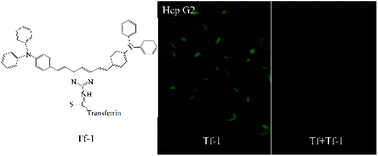当前位置:
X-MOL 学术
›
Photochem. Photobiol. Sci.
›
论文详情
Our official English website, www.x-mol.net, welcomes your feedback! (Note: you will need to create a separate account there.)
Facile synthesis of a two-photon fluorescent probe based on pyrimidine 2-isothiocyanate and its application in bioimaging†
Photochemical & Photobiological Sciences ( IF 3.1 ) Pub Date : 2018-03-07 00:00:00 , DOI: 10.1039/c8pp00071a Jie Yang 1, 2, 3, 4, 5 , Wei Hu 1, 2, 3, 4 , Huirong Li 1, 2, 3, 4 , Hanna Hou 1, 2, 3, 4 , Yi Tu 1, 2, 3, 4 , Bo Liu 5, 6, 7, 8, 9
Photochemical & Photobiological Sciences ( IF 3.1 ) Pub Date : 2018-03-07 00:00:00 , DOI: 10.1039/c8pp00071a Jie Yang 1, 2, 3, 4, 5 , Wei Hu 1, 2, 3, 4 , Huirong Li 1, 2, 3, 4 , Hanna Hou 1, 2, 3, 4 , Yi Tu 1, 2, 3, 4 , Bo Liu 5, 6, 7, 8, 9
Affiliation

|
Two-photon microscopy imaging has been widely applied in biological imaging, but the development of two-photon absorption probes is obviously lagging behind in the development of imaging technology. In this paper, a two-photon fluorescent probe (1) based on pyrimidine 2-isothiocyanate has been designed and synthesized through a simple method for two-photon biological imaging. Probe 1 was able to couple effectively with the amino groups on biomolecules. To verify the reactivity of the isothiocyanate group on probe 1 and the amine groups on the biomolecules, D-glucosamine was chosen as a model biomolecule to conjugate with probe 1. The result showed that probe 1 could effectively conjugate with D-glucosamine to synthesize probe 2, and the yield of probe 2 was 83%. After conjugating with D-glucosamine, linear absorption spectra, single-photon fluorescence spectra, and two-photon fluorescence spectra of probes 1 and 2 did not present significant changes. Probes 1 and 2 exhibited high fluorescence quantum yields (0.71–0.79) in toluene and chloroform. They also exhibited different photo-physical properties in solvents with different polarities. The two-photon absorption cross-section of probe 1 was 953 GM in toluene. In addition, probe 1 could be effectively conjugated with transferrin, and the conjugated probe (Tf–1) could be transported into Hep G2 cells through a receptor-mediated process for biological imaging. These results demonstrate that such probes are expected to have great potential applications in two-photon fluorescence bioimaging.
中文翻译:

基于嘧啶2-异硫氰酸盐的双光子荧光探针的简便合成及其在生物成像中的应用†
双光子显微镜成像已被广泛应用于生物成像中,但是双光子吸收探针的发展明显滞后于成像技术的发展。本文设计了一种基于嘧啶2-异硫氰酸酯的双光子荧光探针(1),并通过一种简单的双光子生物成像方法对其进行了合成。探针1能够与生物分子上的氨基有效偶联。为了验证探针1上的异硫氰酸酯基和生物分子上的胺基的反应性,选择D-葡萄糖胺作为模型生物分子与探针1缀合。结果表明,探针1能有效结合物与d -葡糖胺合成探针2,和探针的收率2率为83%。与D-葡萄糖胺共轭后,探针1和2的线性吸收光谱,单光子荧光光谱和双光子荧光光谱没有明显变化。探针1和2在甲苯和氯仿中显示出较高的荧光量子产率(0.71-0.79)。它们在具有不同极性的溶剂中也表现出不同的光物理性质。探针1的两光子吸收截面为在甲苯中的953 GM。另外,探针1可以有效地与转铁蛋白偶联,偶联的探针(Tf-1)可以通过受体介导的生物成像过程转运到Hep G2细胞中。这些结果表明,期望这种探针在双光子荧光生物成像中具有巨大的潜在应用。
更新日期:2018-03-07
中文翻译:

基于嘧啶2-异硫氰酸盐的双光子荧光探针的简便合成及其在生物成像中的应用†
双光子显微镜成像已被广泛应用于生物成像中,但是双光子吸收探针的发展明显滞后于成像技术的发展。本文设计了一种基于嘧啶2-异硫氰酸酯的双光子荧光探针(1),并通过一种简单的双光子生物成像方法对其进行了合成。探针1能够与生物分子上的氨基有效偶联。为了验证探针1上的异硫氰酸酯基和生物分子上的胺基的反应性,选择D-葡萄糖胺作为模型生物分子与探针1缀合。结果表明,探针1能有效结合物与d -葡糖胺合成探针2,和探针的收率2率为83%。与D-葡萄糖胺共轭后,探针1和2的线性吸收光谱,单光子荧光光谱和双光子荧光光谱没有明显变化。探针1和2在甲苯和氯仿中显示出较高的荧光量子产率(0.71-0.79)。它们在具有不同极性的溶剂中也表现出不同的光物理性质。探针1的两光子吸收截面为在甲苯中的953 GM。另外,探针1可以有效地与转铁蛋白偶联,偶联的探针(Tf-1)可以通过受体介导的生物成像过程转运到Hep G2细胞中。这些结果表明,期望这种探针在双光子荧光生物成像中具有巨大的潜在应用。



























 京公网安备 11010802027423号
京公网安备 11010802027423号